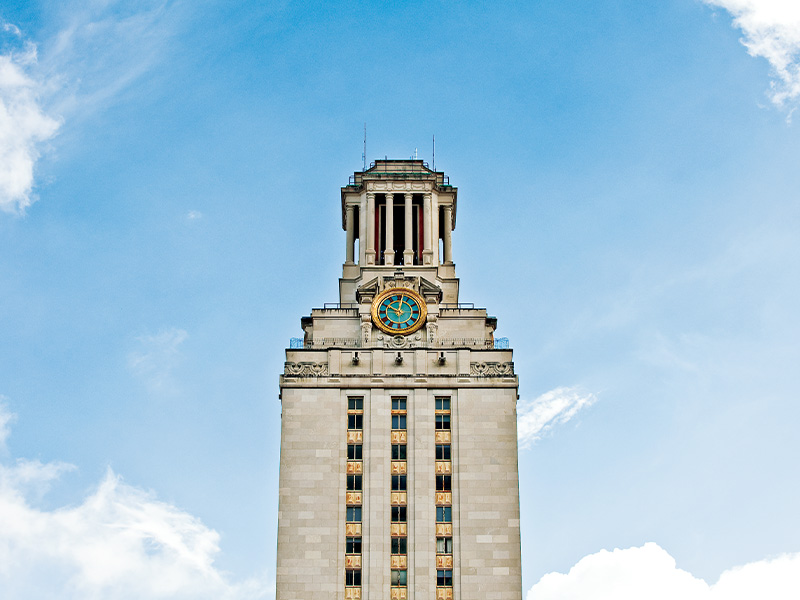Cockrell School Unveils First-of-its Kind 3D Printing Vending Machine

3D printing is rooted in the Cockrell School of Engineering’s past, present and future.
One of the first 3D printing processes (selective laser sintering), which continues to be used in manufacturing today, was invented here three decades ago. A couple of years ago, Texas Engineering students in the Longhorn Startup Program created a fast and cost-effective 3D camera and demonstrated it for President Barack Obama. And just last week, the Cockrell School launched a cutting-edge 3D printing vending machine available for free to all students at The University of Texas at Austin.
The Innovation Station, designed and built by mechanical engineering students led by associate professor Carolyn Seepersad, gives students the opportunity to build objects for a variety of purposes through a web-based portal and queue system.
“The vending machine lowers the barriers to 3D printing,” said Seepersad, who is an expert in additive manufacturing and engineering design. “It will help encourage all UT Austin students to take their ideas from the classroom and their extracurricular activities and bring them to life. This tool will inspire our students to think like entrepreneurs.”
Seepersad, along with visiting associate professor Matthew Green, and a team of students — Joshua Kuhn, mechanical engineering graduate student; Sanjai Bashyam, electrical engineering sophomore; and junior George Garcia and senior Jordan Wahl, both in mechanical engineering — have spent the past year conceptualizing and constructing the Innovation Station.

Carolyn Conner Seepersad, professor in the Cockrell School of Engineering’s Department of Mechanical Engineering
“The Innovation Station gives students the opportunity to create. There are few feelings as rewarding as coming up with an idea and making that idea a reality,” Kuhn said. “It has been amazing to see the Innovation Station start as a cool concept and transform into a project that students can really benefit from. I really enjoyed the experience of taking a concept, prototyping, testing and then manufacturing the final product.”
The team developed the Innovation Station by modifying two commercially available MakerBot printers, adding several unique components and hardware of their own, and optimizing it to print two jobs at once. The team also designed and built the infrastructure that holds the 3D printers, as well as the mechanisms that make it operate like a vending machine, such as the online uploading system and the retrieval process.
After an object is printed and before it is moved into a retrieval drawer for the creator to pick up, the object is removed from the surface using a patent-pending process that the team created. On a typical 3D printer, objects are printed on an acrylic surface that allows the design to stick firmly in one place. As a result, removing a finished product from the printer can require a lot of manual force. So, Seepersad and her team discovered a solution that allows parts to be safely and automatically removed from the printer without manual assistance.
Instead of printing on an acrylic surface, Innovation Station designs are printed on a glass surface with an aluminum panel underneath. The aluminum heats the glass during printing, and once the design is finished, the aluminum separates from the glass surface. A fan cools the glass and the object so quickly that the object pops off the glass and is ready to be pushed into the retrieval drawer.
Using an online queuing and part submission process that is monitored and managed by Seepersad and her team, a student uploads a CAD (computer-aided design) file to the Innovation Station web portal and receives a text message notification when his or her part is being printed. The team provides how-to guides and resources to help students download and learn CAD software to create designs.
“Moving forward, we expect that students will be able to save and share their designs with one another,” Seepersad said. “I hope the Innovation Station serves as a way for all students to collaborate, inspire one another and spark conversations about new ideas for designing and creating.”
The Cockrell School launched the Innovation Station on Sept. 4. View photos from the event.
The Innovation Station is located in the highly trafficked Engineering Teaching Center (ETC) T-Room on the ground level. It is available to all UT Austin students for use during weekdays.
The Innovation Station project received a 2013-14 Longhorn Innovation Fund for Technology (LIFT) grant, which provides seed funding to UT Austin projects that use information technology to improve quality of instruction and address campus needs.
